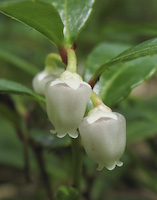Wintergreen
Gaultheria procumbens |
 Other common names:
Checkerberry, Eastern Teaberry, Teaberry Other common names:
Checkerberry, Eastern Teaberry, Teaberry

French names:
Gaulthérie couchée

Family:
Heath Family (Ericaceae)

Distinctive features:
Sub-Shrub; Low plant, tough leaves, wintergreen smell.

Similar species:
•
Fringed Polygala (Polygaloides paucifolia) - no wintergreen smell. See the Ontario Wildflowers website, Fringed Polygala.

Flowers:
Spring, Summer; White; 5 parts (petals); White, hanging down under the leaves.

Leaves:
Alternate, Simple, Toothed; Alternate, simple. Crowded near the top of the plant. Roundish/oblong, tough, evergreen. Aromatic.

Height:
10-15 cm (4-6 in)

Fruit/Seeds:
Red berries hanging down under the leaves, stay on the plant through the winter (if no one eats them!).

Habitat:
Forests; Open forests.

Edible:
Berries are edible. Leaves may be chewed for the wintergreen taste.

Books:
Peterson's Field Guide to Wildflowers: 38
ROM Field Guide to Wildflowers of Ontario: 253
Shrubs of Ontario: 377
Newcomb's Wildflower Guide: 212

Native/Non-native:
Native

Status:
Common.

Origin and Meaning of Names:
Scientific Name: procumbens: with trailing prostrate stems

For more information visit:
Ontario Wildflowers

Photographs:
88 photographs available, of which 5 are featured on this page. SCROLL DOWN FOR PHOTOGRAPHS.

Range Map is at the bottom of the page
 |
 |
|
|
|
|
|
 |